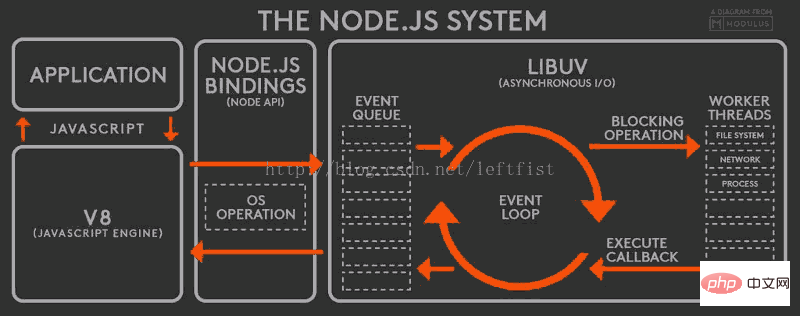
The asynchronous mechanism of node is based on "events". All I/O, network communication, and database queries are executed in a non-blocking manner, and the returned results are processed by the event loop. Node will only process one event at the same time, and immediately enter the event loop to check subsequent events after completion. In this way, the CPU and memory can focus on processing one thing at the same time, while trying to allow time-consuming I/O and other operations to be executed in parallel.

The operating environment of this tutorial: Windows 7 system, nodejs version 16, DELL G3 computer.
NodeJS is single-threaded. Single-threading has the following benefits:
Simple
High performance , avoiding the overhead of frequent thread switching
The resource usage is small, because it is a single thread, and the memory usage is still very low under heavy load
Thread safety, no locking, unlocking, deadlock problems
How to solve high concurrency?
Node uses asynchronous IO and event-driven (callback function) to solve the problem of high concurrency.
Generally speaking, high concurrency solutions will provide a multi-threading model, providing a thread for each business logic, and making up for the time overhead of synchronous I/O calls through system thread switching. Like apache, there is one thread per request.
NodeJS uses a single-threaded model and uses asynchronous request methods for all I/O to avoid frequent context switching. It maintains an event queue when NodeJS is executed; the program enters the event during execution. The loop waits for the next event to arrive. After each asynchronous I/O request is completed, it will be pushed to the event queue for waiting execution.
The asynchronous mechanism of NodeJS is based on events. All I/O, network communication, and database queries are executed in a non-blocking manner, and the returned results are processed by the event loop. As shown in the figure:
The Node.js process will only process one event at the same time. After completion, it will immediately enter the event loop to check subsequent events. The advantage of this is that the CPU and memory can focus on processing one thing at the same time, while trying to allow time-consuming I/O and other operations to be executed in parallel. For low-speed connection attacks, Node.js only adds requests to the event queue and waits for the operating system's response. Therefore, there is no multi-threading overhead, which can greatly improve the robustness of web applications and prevent malicious attacks.
Event loop mechanism
The so-called event loop means that NodeJS will use the event mechanism to solve all asynchronous operations, and there is a thread that continuously loops to detect the event queue.
All logic in NodeJS is the callback function of the event, so NodeJS is always in the event loop, and the program entry is the callback function of the first event in the event loop. The event callback function may issue an I/O request or directly emit the event, and return to the event loop after execution. The event loop checks the event queue for unhandled events until the program ends. The event loop of NodeJS is invisible to developers and is implemented by the libev library. libev constantly checks whether there are active event listeners that can be detected, and does not exit the event loop until no event listeners are detected, and the program ends.

For more node-related knowledge, please visit: nodejs tutorial!
The above is the detailed content of What is the asynchronous mechanism of node based on?. For more information, please follow other related articles on the PHP Chinese website!